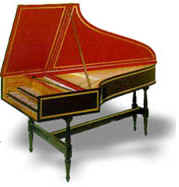Astute and wholesome design, exquisite
workmanship, robust construction, tasteful decoration, and acoustical efficiency - all are
hallmarks of 18th century Germany's Hass family of harpsichord makers. For these reasons,
we have selected the instruments of Hass as prototypes for our German double-manual
harpsichord.
 The
German doubles that now leave our shop represent our enlargement of
pre-1740 designs of Hieronymous Albrecht Hass to the more traditional
18th century, wide-range instrument. Unlike most modern extended designs,
the sound of the extreme treble does not differ from the rest of the
instrument in either quantity or quality. The sound sustains throughout
the range and is capable of a fine legato even in the extreme treble.
The
German doubles that now leave our shop represent our enlargement of
pre-1740 designs of Hieronymous Albrecht Hass to the more traditional
18th century, wide-range instrument. Unlike most modern extended designs,
the sound of the extreme treble does not differ from the rest of the
instrument in either quantity or quality. The sound sustains throughout
the range and is capable of a fine legato even in the extreme treble.
Case walls and bracing are
entirely of spruce, pine or fir. The wrestplank is maple. The soundboard
is European spruce and the bridges and nuts are beech or maple. The
turned-leg trestle stand, similar to the original Hass stand, is relieved
on top to contact the bottom of the instrument only in the vicinity
of the legs. The case is assembled with hand-cut dovetails at each corner
and with the wrestplank and header pegged through the exterior of the
case. These expensive and worthwhile features are seen as shadowed in
the painted finish.
The exterior is normally painted a dark color and
the string surrounds and underside of the lid a contrasting lighter color. Gold bands are
applied to these surfaces (with the exception of the spine) as well as to the mouldings
around the interior edge of the top of the case. Butternut veneer and cherry stringing
inlay cover the keywell. Endblocks and transverse rails are butternut or cherry with
applied mouldings. The natural keys are covered with ebony; the walnut sharps are capped
with bone selected for whiteness.
In his Historischbiographisches Lexicon of 1790,
Ernst Ludwig Gerber wrote, "The Hasses, father and son, made splendid harpsichords
and clavichords which are still much sought after." The passage of
time has not given cause to amend these assessments.
